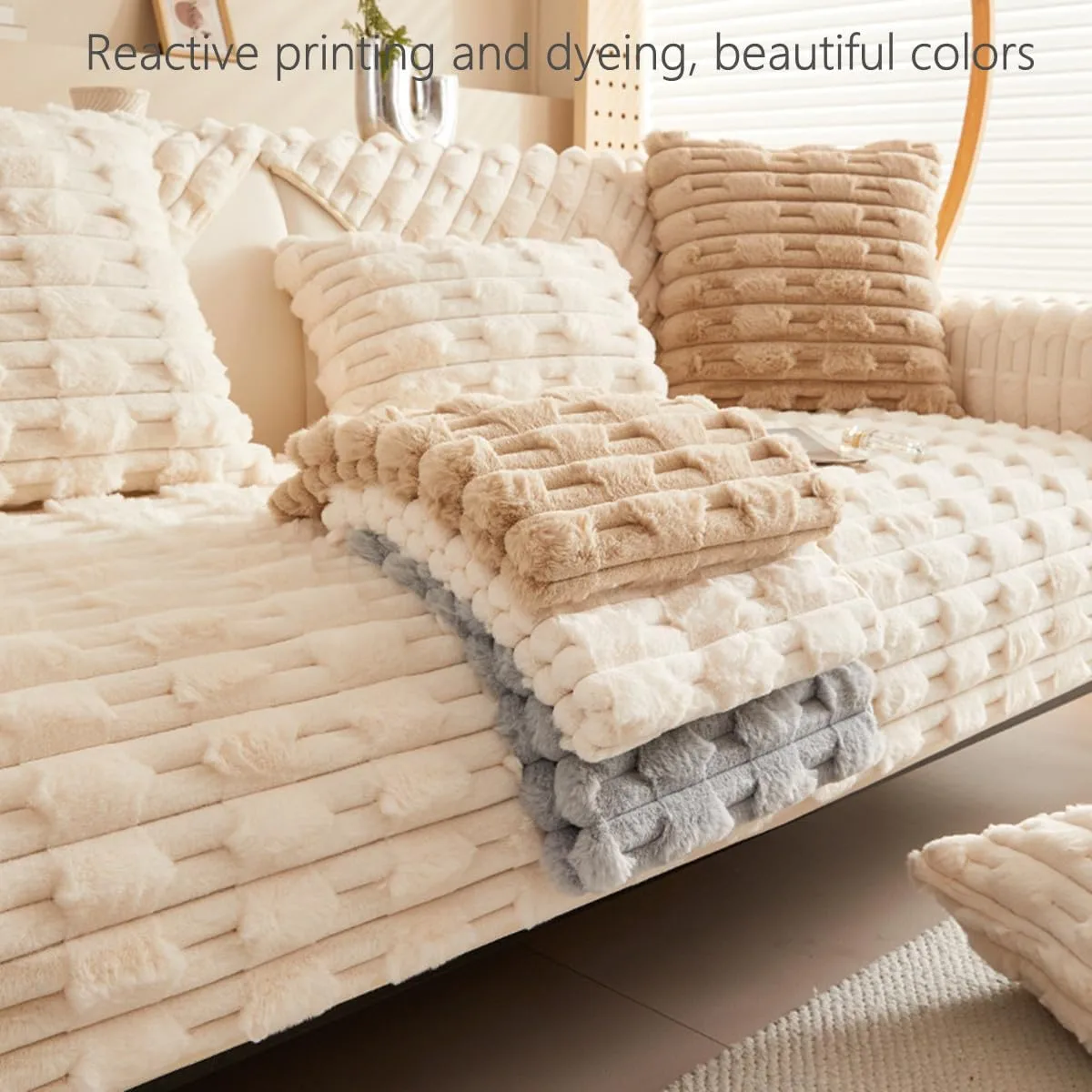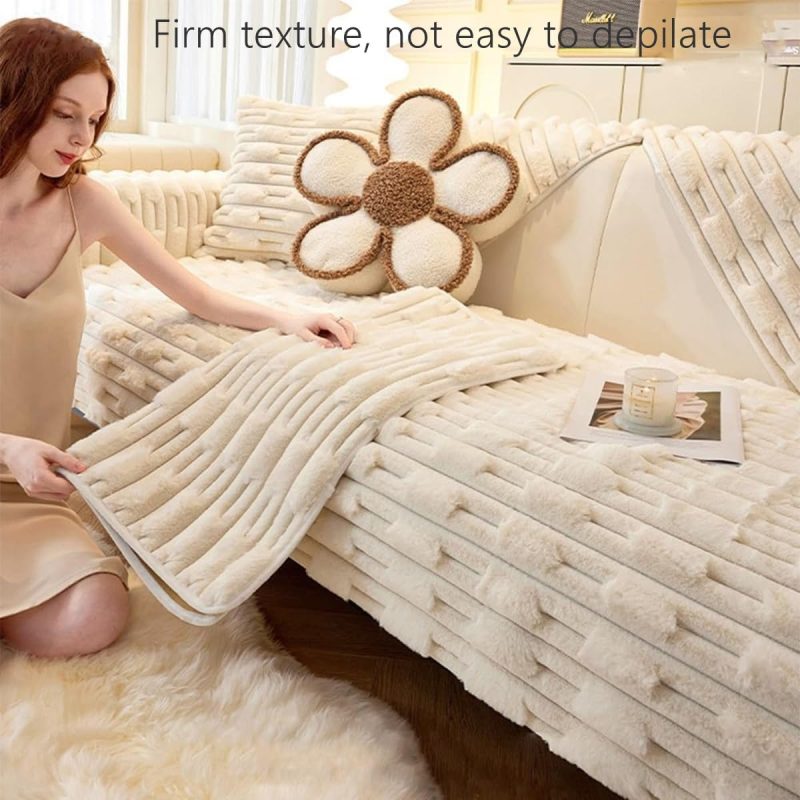The Ultimate Guide to Choosing the Best Non-Slip Cover for Leather Sofas 2024

In the realm of furniture care and maintenance, protecting leather sofas stands as a paramount task for homeowners and interior enthusiasts alike. Leather sofas are prized for their luxurious appeal and durability, making them a centerpiece in many living spaces. However, maintaining their pristine condition can pose challenges, particularly when it comes to finding suitable non-slip covers. These covers not only enhance the aesthetic appeal of your furniture but also provide essential protection against wear, spills, and everyday use.
Leather sofas represent a significant investment, both in terms of cost and aesthetic value. Protecting them ensures longevity and preserves their original beauty over time. Whether you’re safeguarding against pet claws, accidental spills, or simply looking to update the look of your living room, choosing the right non-slip cover is crucial.
Challenges with Finding Non-Slip Covers for Leather Furniture
The unique characteristics of leather, such as its smooth texture and natural oils, pose challenges when it comes to finding covers that stay in place. Traditional covers may slide or bunch up, detracting from both comfort and appearance. This guide delves into the specifics of non-slip sofa covers, detailing what sets them apart and how they address these common issues effectively.
Understanding Leather Sofa Covers

What Are Leather Sofa Covers?
Leather sofa covers are specialized materials designed to fit snugly over your existing sofa, providing a protective layer without compromising on style. They come in various forms, from elasticized designs to those with non-slip backings, each catering to different needs and preferences.
Different Types of Leather Sofa Covers
Choosing the right type of cover depends largely on your lifestyle and aesthetic preferences. Elasticized covers offer flexibility and ease of use, while quilted covers with grips provide enhanced comfort and grip. Understanding these variations helps in selecting a cover that not only fits your sofa dimensions but also complements your interior décor seamlessly.
Benefits of Using Sofa Covers for Leather Sofas
The benefits extend beyond protection; sofa covers can breathe new life into an old piece of furniture or provide a quick seasonal update. They offer a cost-effective solution to changing decor trends without the expense of reupholstering. Moreover, they act as a barrier against dust and allergens, promoting a cleaner and healthier living environment.
Why Non-Slip Covers are Essential for Leather Sofas
Leather is a luxurious and smooth material, known for its durability and classic appearance. However, its inherent slipperiness poses a challenge when it comes to using traditional sofa covers. The slick surface of leather makes it difficult for regular covers to stay in place, leading to issues like shifting and bunching. This not only affects the look of your sofa but can also make it uncomfortable to sit on. Non-slip covers address these problems by using specialized materials and designs that adhere securely to leather, maintaining a neat and stylish appearance.
The Nature of Leather and Its Slick Surface
Leather’s inherent slipperiness makes it prone to shifting under traditional covers. Non-slip covers are specially engineered with materials that adhere securely to leather, preventing unwanted movement and maintaining a neat appearance.
Problems with Regular Sofa Covers on Leather
Standard sofa covers often lack the necessary grip to stay in place on leather surfaces. This can lead to constant readjustment and frustration, compromising both the comfort and aesthetics of your seating area.
How Non-Slip Covers Prevent Sliding and Enhance Comfort
Non-slip covers employ innovative designs such as rubberized backings or gripping mechanisms that anchor the cover to the sofa. This ensures a smooth, taut fit that not only prevents slipping but also enhances seating comfort by eliminating wrinkles and creases.
Key Features to Look for in Non-Slip Sofa Covers
When selecting non-slip sofa covers, it’s important to look for features that ensure both functionality and durability. Here are some key features to consider:
1. Anti-Slip Backing
- Rubberized or Silicone Backing: Provides strong grip on smooth surfaces like leather, preventing the cover from shifting.
- Textured or Padded Underside: Creates friction to help keep the cover in place.
2. Elasticized Edges
- Stretchy Fabric: Ensures a snug fit by conforming to the shape of the sofa.
- Elastic Hems: Helps the cover stay securely in place, especially on sofas with arms and back cushions.
3. Adjustable Straps or Ties
- Securing Mechanisms: Straps or ties that can be fastened around the sofa legs or under cushions to keep the cover from moving.
- Adjustable Features: Allows customization to fit different sofa sizes and shapes.
4. Quality of Material
- Durable Fabrics: Look for materials like microfiber, polyester blends, or faux leather that are resistant to wear and tear.
- Comfort: Soft, breathable fabrics can add a layer of comfort to your seating.
5. Fit and Size Options
- Custom Fit: Available in various sizes or customizable to match your sofa’s dimensions.
- Coverage: Ensures that all parts of the sofa, including arms, cushions, and back, are covered.
6. Ease of Cleaning
- Machine Washable: Covers that can be easily removed and washed in a machine for convenience.
- Stain Resistance: Fabrics that are resistant to stains or spills, making maintenance easier.
7. Design and Aesthetics
- Color and Pattern Choices: Available in a variety of colors and patterns to match your decor.
- Non-Intrusive: Designed to blend well with your existing furniture and enhance the overall look of the room.
8. Comfort Enhancements
- Padding: Some covers come with added padding or cushioning for extra comfort.
- Wrinkle Resistance: Materials that minimize creasing and maintain a smooth appearance.
9. Compatibility
- Multiple Sofa Types: Some covers are designed to fit different types of sofas, including sectional or recliner sofas.
- Non-Slip Variants: Covers specifically engineered to work well with leather or other smooth surfaces.
10. Installation and Adjustment
- User-Friendly Design: Easy to install and adjust, with clear instructions.
- Secure Fit: Once in place, the cover should remain stable without needing frequent readjustment.
By considering these features, you can find a non-slip sofa cover that not only stays in place but also enhances the comfort and appearance of your leather sofa.
Different Types of Non-Slip Sofa Covers for Leather Sofas
When choosing a non-slip sofa cover for a leather sofa, you have several options depending on your needs and preferences. Here are some popular types:
- Elasticized Covers: These covers have an elastic edge that fits snugly around the sofa, helping to keep it in place. They’re often made of stretchy materials like spandex or polyester.
- Slip-Resistant Backing: Some sofa covers come with a special non-slip backing or rubberized grip that prevents the cover from sliding around. This type is especially useful for leather sofas, as the smooth surface can make other covers more prone to slipping.
- Anti-Slip Straps: These covers include adjustable straps or ties that can be secured around the sofa legs or under the cushions. They help keep the cover in place even with heavy use.
- Foam Padding: Covers with built-in foam padding or inserts can add extra grip by creating friction between the cover and the leather surface. This type of cover often provides a snug fit and additional comfort.
- Mat-Style Covers: Some non-slip covers are designed like mats, with a textured surface that adheres to the sofa. These are typically made of materials like microfiber or felt.
- Customized Covers: Custom-made sofa covers can be tailored specifically to the dimensions of your leather sofa, ensuring a perfect fit and minimizing the risk of slippage.
When selecting a cover, consider factors such as the color and style you prefer, how easy it is to clean, and how well it will fit your sofa.
Top Materials for Non-Slip Sofa Covers
When choosing non-slip sofa covers, the material can significantly impact both functionality and comfort. Here are some of the top materials used for non-slip sofa covers:
- Microfiber: Known for its softness and durability, microfiber is a popular choice. It has a naturally textured surface that can help reduce slipping. Microfiber covers are often easy to clean and maintain.
- Faux Leather: Faux leather can be a good option for a non-slip cover, especially if you want a matching look for a leather sofa. It has a smooth surface but can be designed with anti-slip backing to prevent slipping.
- Polyester Blends: Polyester is a versatile material that, when blended with other fibers like spandex, provides stretch and a snug fit. Some polyester blends are designed with anti-slip features or backing.
- Rubberized or Silicone Backing: Some covers have a rubberized or silicone backing that provides excellent grip on smooth surfaces. This backing helps to keep the cover in place even on leather sofas.
- Cotton: While cotton alone might not be as slip-resistant, many cotton covers come with additional features like elasticized edges or anti-slip backing to enhance their performance.
- Spandex: Spandex or elastane materials are highly stretchable and can conform closely to the shape of your sofa. They often have a snug fit that reduces slipping, especially when combined with other materials.
- Felt or Non-Slip Mats: Some covers are designed with a felt or mat-like texture that provides extra grip. These can be effective at keeping the cover in place, although they may be less common for sofa covers compared to other materials.
When selecting a material, consider your sofa’s usage, the ease of cleaning, and how well the material complements your existing decor.
Best Practices for Installing Non-Slip Covers on Leather Sofas
Installing a non-slip cover on your leather sofa helps protect it and keeps it looking great. Follow these best practices to ensure a perfect fit and secure placement:
1. Clean and Prepare the Sofa
- Dust and Clean: Before installation, thoroughly clean your leather sofa to remove dust and debris. This helps the cover adhere better.
- Dry Surface: Make sure the leather is completely dry before putting on the cover to ensure a good fit.
2. Choose the Right Size
- Measure Accurately: Measure your sofa’s width, depth, and the height of the arms and back. Compare these measurements with the cover’s specifications to ensure a good fit.
- Fit Check: Confirm that the cover is designed for your type of sofa (e.g., sectional, recliner) and is the correct size.
3. Align and Position the Cover
- Position Properly: Place the cover over the sofa, aligning it to cover the entire surface, including arms, back, and cushions.
- Smooth Out Wrinkles: Smooth out any wrinkles or creases to ensure an even fit.
4. Secure the Cover
- Elastic Edges: If the cover has elastic edges, pull them tightly around the sofa’s edges to create a snug fit. Ensure the elastic is properly seated under the cushions.
- Straps or Ties: Use any included straps or ties to secure the cover around the sofa legs or under the cushions. Adjust as needed for a tight fit.
- Rubberized Backing: If the cover features rubberized or silicone backing, press it firmly against the leather for better grip. Ensure even coverage.
5. Adjust and Check the Fit
- Make Adjustments: After securing the cover, adjust as needed to ensure a smooth and even fit. Remove any remaining wrinkles or bunching.
- Test Stability: Sit on the sofa to check the cover’s stability. Make any necessary adjustments if the cover shifts.
6. Regular Maintenance
- Inspect Often: Regularly check the cover to ensure it stays securely in place. Adjust as needed.
- Follow Cleaning Instructions: Clean the cover according to the manufacturer’s instructions to keep it looking fresh and performing well.
7. Avoid Over-Stretching
- Handle Gently: Avoid pulling or stretching the cover too much during installation. Install it gradually to prevent damage.
8. Protect the Leather
- Add Padding: Consider using a thin protective layer between the leather and the cover if the cover lacks built-in padding. This helps prevent wear and tear.
By following these steps, you’ll ensure that your non-slip cover stays in place, protecting and enhancing your leather sofa’s appearance and comfort.
How to Maintain and Clean Non-Slip Covers
Maintaining and cleaning non-slip sofa covers is essential for their longevity and performance. Regularly inspect the cover for any signs of wear and tear, and adjust it if it starts to shift. Always follow the manufacturer’s cleaning instructions. For minor spills, spot clean with a mild detergent and damp cloth, avoiding rubbing. If the cover is machine washable, use a gentle cycle with cold water and avoid fabric softeners.
For hand washing, use a mild detergent mixed with lukewarm water, gently clean the cover, and rinse thoroughly. Air dry the cover by laying it flat, away from direct sunlight, and check for any shrinkage or changes in fit. To deal with odors, sprinkle baking soda on the cover, let it sit, and then vacuum it off. For preventive maintenance, use throw blankets to reduce direct contact and blot spills immediately. Regularly vacuum the cover to remove dust and crumbs, and ensure it stays securely in place with minimal shifting.
DIY Non-Slip Solutions for Leather Sofas
If you’re looking for DIY non-slip solutions for your leather sofa, several methods can effectively keep your cover in place. One simple approach is to use rubber shelf liners. Cut them to fit the seat and back of the sofa, placing them under the cover to create a non-slip surface that provides excellent grip and protects the leather. Another option is to use Velcro strips; attach adhesive strips to both the underside of the cover and corresponding areas on the sofa for a secure hold that is easy to adjust and remove.
Double-sided tape offers a quick fix as well; apply it to the underside of the cover or directly onto the leather to prevent shifting. For a more textured grip, rubber gripper pads or non-slip furniture pads can be placed between the sofa and the cover, enhancing friction and stability. Fabric spray adhesive provides a semi-permanent solution by lightly spraying the adhesive on the cover’s underside before placing it on the sofa. Alternatively, you can use fitted sheets or bedspreads as a makeshift cover, stretching them over the sofa and tucking the edges under the cushions for a snug fit.
For a more durable option, apply small beads of silicone caulk to the sofa’s surface where the cover contacts it, creating a textured surface that helps prevent slipping. Lastly, consider attaching gripper fabric, like those used for non-slip rugs, to the cover’s underside for a custom, secure solution. Each of these methods offers a practical way to keep your sofa cover in place, protecting your leather sofa and enhancing comfort.
Addressing Common Issues with Non-Slip Sofa Covers
Non-slip sofa covers are designed to enhance the functionality and aesthetic appeal of leather sofas by preventing slippage and providing protection. However, like any product, they can present certain issues. This section will address common problems encountered with non-slip sofa covers and provide practical solutions.
Dealing with Wrinkles and Slipping
Wrinkles and Slipping are frequent issues with non-slip sofa covers, even when designed to stay in place. Here’s how to handle them:
1. Ensuring Proper Fit
- Measurement Accuracy: Ensure that the sofa cover is correctly sized for your sofa. Measure your sofa dimensions carefully and compare them with the cover’s specifications. A cover that is too large or too small will not fit snugly, leading to wrinkles and potential slipping.
- Adjustable Straps and Ties: Many non-slip covers come with adjustable straps or ties. Make sure these are properly tightened to secure the cover in place and reduce wrinkles.
2. Wrinkle Reduction Techniques
- Smooth Out Wrinkles: After installation, use your hands to smooth out any wrinkles. For stubborn wrinkles, consider using a fabric steamer on a low setting to help relax the fabric and reduce creases.
- Use a Furniture Roller: A furniture roller or a similar tool can help push the cover into the crevices of the sofa and smooth out wrinkles.
3. Anti-Slip Measures
- Non-Slip Underlay: For extra grip, you can place a non-slip underlay or rug pad between the sofa and the cover. This helps keep the cover from shifting and adds an additional layer of grip.
- Rubberized Backing: Ensure that the cover has a good quality rubberized backing designed to grip leather surfaces. If the rubber backing is worn out, consider replacing the cover.
Fixing Wear and Tear Issues
Wear and tear can occur over time, affecting the appearance and effectiveness of your non-slip sofa cover. Here’s how to address these issues:
1. Repair Minor Damages
- Fabric Patches: For small tears or holes, use fabric patches or a fabric repair kit. These are available at most home improvement or craft stores and can be applied according to the product instructions.
- Sewing: For more significant tears, consider sewing the damaged area with a strong needle and thread. This method is particularly effective for fabric covers.
2. Regular Maintenance
- Clean Regularly: Follow the cleaning instructions provided with the cover. Regular cleaning helps maintain the cover’s appearance and prevents fabric deterioration.
- Check for Loose Threads: Periodically inspect the cover for loose threads or other signs of wear. Trim any loose threads to prevent them from unraveling further.
How to Improve the Fit of Your Cover
Improving the fit of a non-slip sofa cover can resolve many issues related to slippage and appearance. Here’s how to achieve a better fit:
1. Reinstall with Precision
- Follow Installation Instructions: Reinstall the cover according to the manufacturer’s instructions. Ensure all corners and edges are properly aligned and fitted.
- Tuck Excess Fabric: Use the tuck method to insert any excess fabric into the gaps between the cushions and the sofa. This helps create a more streamlined and secure fit.
2. Use Fit Enhancers
- Foam Inserts: Some covers come with foam inserts designed to fit into the crevices of your sofa. These inserts help hold the cover in place and reduce movement.
- Non-Slip Grips: Additional non-slip grip pads or silicone strips can be added to the underside of the cover to enhance its grip on the leather sofa.
Preventative Measures
To minimize future issues with non-slip sofa covers, consider these preventative measures:
1. Choose Quality Covers
- High-Quality Materials: Invest in a high-quality non-slip sofa cover made from durable materials. Better quality covers are less likely to wear out or slip over time.
- Brand Reputation: Opt for reputable brands known for their effective non-slip designs and reliable products.
2. Regular Adjustments
- Periodic Checks: Regularly check the cover’s fit and adjust as needed. This proactive approach helps address potential issues before they become significant problems.
By addressing these common issues with non-slip sofa covers, you can enhance the functionality and longevity of your leather sofa protection. Implement these solutions to ensure a snug fit, reduce wrinkles, and manage wear and tear effectively.
Frequently Asked Questions (FAQs)
Can Non-Slip Covers Damage Leather Sofas?
Non-slip covers are designed to protect rather than damage leather sofas when used correctly. Ensure proper fit and care to avoid potential issues.
How Often Should I Clean My Non-Slip Sofa Cover?
Regular cleaning schedules depend on usage and material type. Follow manufacturer guidelines for optimal maintenance.
Are There Any Alternatives to Non-Slip Sofa Covers?
Explore alternative solutions such as slip-resistant mats or custom upholstery for specific needs and preferences.
What is the Average Lifespan of a Non-Slip Sofa Cover?
Lifespan varies based on material quality and usage. Quality covers can last several years with proper care and maintenance.


